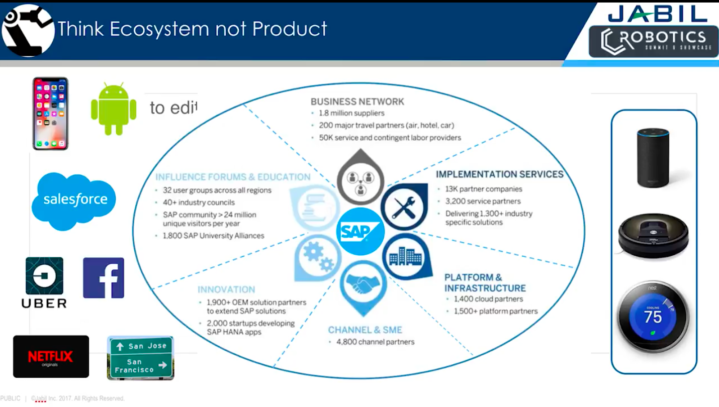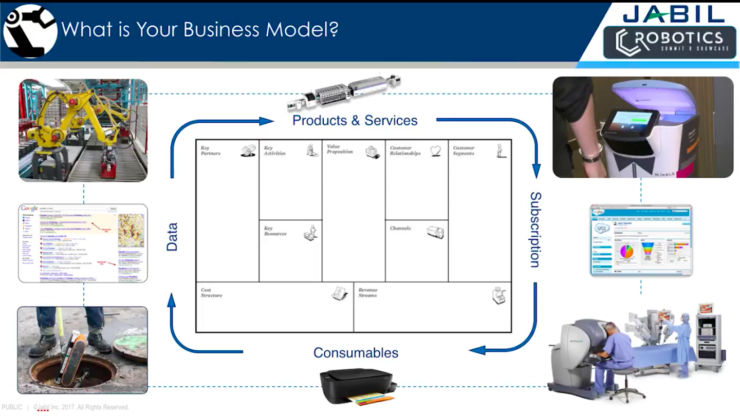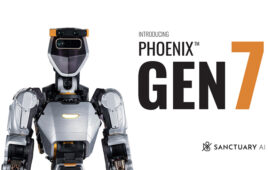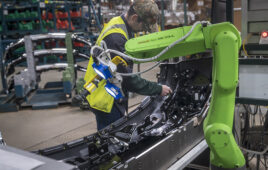During his keynote at the Robotics Summit & Showcase, Jabil VP of Global Automation and 3D printing John Dulchinos discussed the challenges robotics companies face while developing commercial class robotics systems. Is your team thinking big picture during early stage planning? Are they looking beyond specific product details to focus on how the product functions in the system at large?
Here are five essential questions Dulchinos says you must consider during robotics development.
Are you a platform or solutions company?
Platform companies create partial solutions to technological challenges that other companies can then integrate their products with to create a consumer level solution. It’s an enticing business model. The initial investment for a platform company is fractional compared to developing a complete, market-ready solution. The challenge is convincing potential partner companies that you have a reliable platform already prepared for growth. This partnership recruiting stage requires a substantial investment in business development and marketing.
Industrial robot companies are platform companies. Few are solving problems outright. This business can certainly work; it does for many robotics companies. However, Dulchinos says the most successful robotics company create complete solutions.
“While the vast majority of robot companies sit on the platform side, the most successful ones sit on the solutions side. If you really want to get funded, it’s about ‘how do you align to a market where you can deliver a solution.'”

Are You Thinking Ecosystem?
Dulchinos describes a complete ecosystem solution as a “platform on steroids.” Not a product, ecosystems are interconnected environments involving several players each offering different contributions to achieve a result. Dulchinos uses multinational software company SAP as an example of an ecosystem-focused company.
“They have six categories of partners: Business networks, implementation services, platform and infrastructure, channel & SME, innovation, and influence forums & education. When you look at the number of partner companies for each section – this is why a company like SAP can serve a wide range of markets and deliver full, end-to-end solutions.”
Thinking beyond product and into the broader ecosystem environment is the best way to enact change within the marketplace. Growth opportunities a greater with an ecosystem than the more one-dimensional single product offering.

Who is Your Real Competitor?
Say you are an incumbent player in a given market. The growth of your product/solution might look something like this: First, you provide a solution for a customer base. Eventually, you begin to receive feedback from influential power users. This feedback helps you improve your solution. As you continue to advance your product using this customer feedback, you eventually reach the point where your product eclipses initial markets requirements. As problems go, there are worse spots to be in.
But Dulchinos refers to renown Harvard Business School Professor Clayton Christenson’s analysis that this is the point where smaller, more nimble startups look to disrupt the market.
“You do a great job serving the power users, but you open the door for some little startup company creating a minimum viable product that serves the very bottom of the market. And then they start to get a little bit better, and a little bit better … until they surpass the baseline of the industry. Pretty soon they’ve disrupted the vast majority of your customer base, and you’re relegated to this further and further, far-reaching part of the market.”
Ouch. Cautionary tales include Uber’s disruption of the taxi market, Waymo’s potential disruption of Uber with its autonomous vehicles, and the decline of Kodak.

What is Your Network Effect?
Network effect is relatively straightforward in the digital space. Users create data, algorithms use that data, and then you refine your service based off that data. This analysis leads to a better overall solution, resulting in more users. All of this, of course, creates more data for you to feed into algorithms – fortifying information accuracy and value.
Repeat.
This process eventually creates a sort of self-sufficient cycle of productivity. Several blue-chip companies like Google, Facebook, Amazon, and Waze all use this model to develop powerful revenues and profit margins. With a small number of users, this model might not have as much impact. But if you have a billion users, a dataset that comprehensive is a very powerful company asset.

What is Your Business Model?
Common in the startup community, online business model canvases are an easy way for you to address some classic business interconnects. The canvasses help you evaluate objectives and, more importantly, determine how to monetize the relationship between customers, expenses, and resources — an excellent exercise if you have not already done so.
For Dulchinos, robots represent four classic business model opportunities. The first and most classic of all is:
“You sell a robot, for a large capital expenditure, you get the money, you may have some services associated … and that’s how you make money. Most of the stuff that goes into manufacturing plants operate by that principle. The problem is, it’s really lumpy. You get a good quarter, it’s great, but then people are digesting it, and you don’t have any sales for a while.”

John Dulchinos, VP, Global Automation and 3D Printing, Jabil
This lack of growth stability has led venture capitalists to begin pushing the second type of business model, subscription-based services. At present, most VC-funded robot startups are moving in this direction. Essentially, you’re renting out your equipment for a monthly fee.
To do this, though, you must first have a functioning solution and plenty of money. Under this business model, you have to fund the capital investment and then amortize it as your customers pay the rent on your product. This is a good strategy when playing the long game, but in the short term, upfront costs can be challenging.
The third model, made famous by companies like Gillette, HP and Intuitive Surgical, involves locking users into your solution and keeping them long-term. For example, HP provides users with high-margin inkjets that sell for 90% gross margin and then users, ideally, stay with the product in perpetuity.
The last business model focuses on data. All major players in the digital economy thrive here – Google, Facebook, Snapchat, etc. Data is harvested and sold for profit.
Pinpointing the most effective business model for your product is an essential early-stage decision for maximizing your solution’s potential.





Tell Us What You Think!